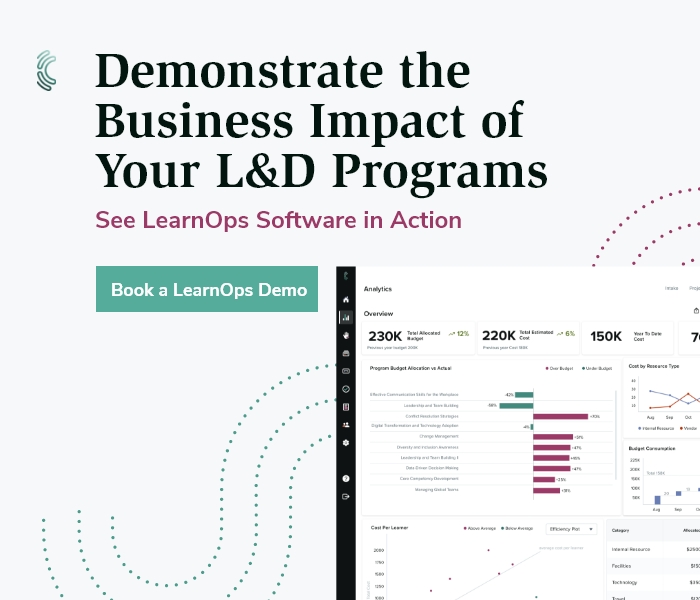As the pace of business increases and unpredictable market forces continue to influence strategy and decision-making, it seems like it’s never been harder to create a plan and stick with it.
Many organizations are still creating 3-5 year strategies, but they need to be more agile and flexible than ever. Successful businesses (and successful functions within them) are those that can quickly adapt.
Learning and development has steadily carved out a new pathway within the organization in recent years. Executives are sitting up and taking notice of the function’s strategic relevance and potential impact on business success. External forces such as skills obsolescence, global pandemics, and labor shortages have no doubt contributed to the acceleration of this new strategic role for L&D.
Now that L&D has reached this point, strategic planning is more crucial than ever. Effective learning and development planning is critical to ensuring that employee training can deliver on its promises and directly contribute to business performance.
So, what should training planning look like for L&D teams in this new, agile business landscape?
What is included in a training plan?
An L&D plan needs to go beyond a list of courses that you plan to develop throughout the year. It also needs to cover every aspect of the function, from strategy and resource planning to business alignment.
Without this granularity, L&D departments will struggle to move beyond order-taking from the business for ineffective learning interventions and towards a strategically aligned performance influencer.
Comprehensive L&D Strategy
All learning and development planning should begin with a detailed, comprehensive learning strategy for the organization. A well-developed strategy encompasses everything from your learning and development goals to how and when you plan to execute them within a given timeframe.
While it can take some time and a fairly extensive level of collaboration with business partners, your L&D objectives should align with the needs and goals of the organization. Once you have clearly defined objectives in place, it becomes much easier to devise training plans that add value and make the best use of your resources.
As part of your training strategy development, you might consider processes such as a detailed learning needs assessment within the organization.
Learning and Development Resource Planning
It’s good to be ambitious with your L&D strategy. But very few teams have an unlimited amount of resources available. So, another key element of successful L&D planning is prioritization.
First, you need to understand what resources are available to you and your team. How many FTE hours will you have throughout the year? What size budget are you working with?
Next, analyze your resource availability against the demand any planned initiatives will place on these resources. Prioritize initiatives, learning development time, and budget allocation against the impact you expect initiatives to have.
Cognota has Capacity Planning and Resource Allocation features specifically designed for L&D teams, so you can balance the demand for training against the capacity and availability of your team at any given time. Try a free trial or book a demo to see for yourself.
What makes a good training plan?
Aside from building out your planned training initiatives, successful learning and development plans also have some core focus areas and characteristics. These items are the difference between creating a well-structured plan and being able to effectively execute it.
Effective Frameworks and Learning Operations
Learning and development strategies are complex and comprise a lot of moving parts. Bringing your objectives to fruition requires the structure, workflows, and processes needed to implement tactics and initiatives effectively.
From the way you work with business partners to how you schedule and track your learning projects, the operations behind your L&D team are the engine room of your strategy implementation. This includes processes and operational considerations such as:
- The structure and skills base of your L&D team
- Training intake and needs assessment
- Project prioritization and planning
- Collaboration with team members, stakeholders, and SMEs
- Project tracking and task management
- Course toryboarding, design, and development
- Content management and updates
- Budget allocation and tracking
- Resource management and capacity planning
Regardless of the size and structure of your L&D department, operational efficiency increases the capacity of your team and the impact they can have on the organization.
Learning Technology Ecosystem
Mature L&D operations need the right technology behind them to ensure these processes run quickly and smoothly. Many areas of learning operations are also interconnected. But without the right technology in place, processes, documentation, and collaboration remain siloed and disjointed.
Many L&D teams continue to rely on email, spreadsheets, shared files, and generic tools to manage and run their operations. This leaves team members struggling to collaborate efficiently. Important tasks and documentation slip through the cracks, work is often duplicated, and hours are wasted moving from one tool to another throughout the learning lifecycle.
For plans to be executed well, learning and development needs a mature and streamlined learning tech stack. Starting with a learning operations platform and including authoring tools and learning delivery technology, the learning tech stack needs to integrate, both from one L&D tool to another and with wider business technology.
Not only does this provide data and insights needed for informed planning and decision making, but it also elevates the productivity and efficiency of the entire learning lifecycle.
Business Alignment
As a support function within the organization, learning and development needs to wear multiple hats. While L&D should take the lead from the business in terms of training needs (preferably in a data-driven environment), they must also act as advisors to business partners.
Taking on both these roles is the difference between operating as a department that takes orders blindly from the rest of the business and becoming a strategic influencer and partner that contributes directly and deliberately to business success.
Many L&D teams have successfully positioned themselves as strategic influencers in the organization, and there are many ways to achieve this. For example, some establish learning advisory committees to engage business partners and executives so that learning interventions add value and align with business objectives.
Regardless of how you achieve it, business alignment is critical to a successful L&D plan. Without it, L&D are left to take last-minute training requests form the business. Or, other departments take training into their own hands without guidance from the team that knows best when it comes to learning interventions.
Buy-In From Stakeholders and Executives
Getting buy-in for training from department managers is one thing. They see the day-to-day need for learning intervention and are naturally more in touch with the performance goals and career aspirations of individual employees.
However, when it comes to budget approval, increasing headcount, or implementing large scale training programs, you need buy-in from higher up the chain. Championship from executive and senior stakeholders is also critical to smoothing the path with any corners of the organization who may be resistant to training or partnership with L&D.
From getting your learning plans approved to support for implementation,
Measuring L&D Success
When you get buy-in from senior management within your organization, it’s imperative that you can prove the results of learning investments. The ability to prove the impact of L&D, especially when that impact can be tied directly to the bottom line of the business, ensures that your department receives the resources it needs.
When it comes to future learning and development planning, the ability to measure L&D success also enables you to:
- Validate past decisions
- Eliminate training initiatives that lack impact
- Focus resources on effective learning solutions and investments
- Understand where extra resources or capabilities are needed within the department
How to Create a Successful Training Plan
Whether you’re overhauling an existing strategy or starting from scratch, it can be difficult to know where to begin with training and development planning. Best practice is to start as broad as possible and narrow down the focus of your strategy as you go.
Start with the overall objectives and needs of the organization and steadily work down towards the needs and preferences of individual teams or employees. If you’re starting with a training needs analysis (try this template), these two areas of focus can work in tandem, so you create an L&D strategy that combines corporate objectives with grassroots input from employees and their managers.
Assess Business Training Needs
At this stage of the training planning process, the first priority is to ensure the L&D strategy is aligned with overall corporate objectives. If your organization does a good job of communicating corporate objectives to individual business units, you’ll have a much easier time understanding how to create and prioritize resources and initiatives for your internal department strategy.
Other learning leaders may find themselves needing to hunt down information and collaboration with business partners to understand their goals and priorities for the months ahead. This is where ongoing partnerships such as a learning advisory committee come in useful.
While corporate objectives are an essential part of planning for learning and development, things can change and change quickly. So, while your strategy should align with organization-wide objectives, be prepared to remain agile and flexible.
Determine Learner Needs and Preferences
The C-suite and department leaders may have one idea of the learning initiatives needed. Employees and their line managers may have another idea entirely. While impacting the performance of the business is top priority, employee buy-in and engagement is essential for the success of any learning intervention.
So, whether it takes place alongside an analysis of corporate strategy or after, a comprehensive needs analysis of training and skills development ensures that:
- Employees feel listened to and engage with learning initiatives
- Grass-roots skills gaps are bridged effectively
- Learning content that is appropriate for existing and desired skill levels is developed
Many L&D teams perform a needs analysis like this through detailed questionnaires from both managers and employees. By including questions such as priority level, business impact, and the size of the audience for a potential learning solution as part of these questionnaires, L&D can better select and prioritize projects to include in their planning.
Assess L&D’s Capabilities and Capacity
Last but certainly not least, L&D must assess the demand for training that emerges from corporate goals and needs analysis and balance it against their available resources. Initiatives must be carefully planned for and scheduled to ensure that your team has the capacity to create learning interventions on time and to a high quality.
Understanding the capabilities and capacity of your team also helps you to create a business case for learning and development workforce planning so you have the budget, headcount, outsourcing, and resources needed to fulfill demand.
Centralize the Planning and Tracking of Your L&D Projects
There’s a lot that goes into effective L&D planning, and spreadsheets don’t quite cut it when it comes time for implementation and tracking. With Cognota, you can plan and manage team capacity, track project progress, and gain insights and visibility into L&D’s resource management, training demand, and more. Check out what Cognota can do for your L&D team’s efficiency and impact with a free trial or by booking a demo.







